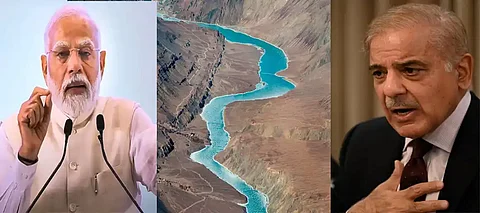

In the aftermath of the deadly Pahalgam Terror Attack, India finally struck back, sending shockwaves in Pakistan. Without lifting any gun or using military power, India carried out a diplomatic strike after putting the Indus Water Treaty in abeyance. Pakistani Army Chief Aseem Munir, who a few back called Kashmir their 'Jugular Vein', has now been put on the backfoot after New Delhi grabbed their jugular vein that was the Indus Water Treaty.
Addressing the media after Prime Minister Narendra Modi chaired the Cabinet Committee on Security (CCS) meeting which lasted for over two hours, Foreign Secretary Vikram Misri announced several measures "recognising the seriousness" of the terrorist attack, including holding in abeyance with immediate effect the Indus Waters Treaty of 1960 until Pakistan "credibly and irrevocably abjures its support for cross-border terrorism".
Indus Water Treaty allocated 3 eastern rivers—Ravi, Beas, and Sutlej—to India, and the 3 western rivers—Indus, Jhelum, and Chenab—to Pakistan. However, India was restricted from fully utilizing the water of the western rivers despite them flowing through Indian territory. Under the current provisions of the treaty, India is permitted limited use of the western rivers for irrigation, power generation, and transport. However, the treaty does not allow the construction of storage dams, significantly limiting water use potential in states like Punjab and Jammu & Kashmir.
If India stops water supply to Pakistan, the people, including farmers there will face an acute water shortage. Not only this, but Pakistan, which is already in economic turmoil, will start suffering from a power shortage even more.
Journalist Sushant Sinha on his YouTube channel said, "Under the Indus after Treaty, Sindhu has been divided into 6 water bodies- Beas, Ravi, and Sutlej are controlled by India, whereas Indus, Jhelum, and Chenab are used by Pakistan. In 1948, India had stopped the water from only 2 water bodies to Pakistan due to their continuous infiltration attempt. Due to this, 17 lakh acres of land in Punjab i,n Pakistan, got affected."
"When Mehbooba Mufti was CM she used to say that Jammu and Kashmir is suffering Rs 20,000 crore of loss due to the Indus Water Treaty. So, it will benefit Kashmir. The Tarbela located on the Indus River of Pakistan, generates 16% of the country's electricity. If India stops water, the plant will be left with no water, resulting in a blackout in Pakistan.
Since the Indus, Jhelum, and Chenab do not originate in Pakistan, the country is heavily reliant on the treaty as it receives about 80% of the total water flow from these rivers. It is vital for agriculture and irrigation in the Pakistani provinces of Punjab and Sindh. In fact, the Punjab province produces 85 per cent of the country's food. Moreover, being an agrarian economy, the agricultural sector contributes nearly 25% to Pakistan's coffers and is the only source of income for 70% of its rural population.
India's abeyance in the Indus Water Treaty will not impact Pakistan overnight. The move from New Delhi will impact Pakistan in the long run. In a layman's language, India's abeyance does not mean an immediate halt to water flowing to Pakistan.
As per India Today report, currently, India doesn't have the infrastructure to stop the flow of water from the Indus rivers into Pakistan, or divert it for its own use. At most, India can cut water flows by 5-10%.
Notably, the treaty bars India from building reservoir dams on the Indus, Jhelum, and Chenab. However, to counter this, India can develop hydroelectric "run-of-the-river" projects. It means that the projects cannot alter the flow of water or obstruct it. Suspending the treaty means India may not adhere to these restrictions and begin constructing reservoir dams to plug the water flow.
It is obvious that building large reservoirs on these rivers will take years, if not a decade. It would require extensive surveys and funding for such a thing to fructify, considering the ecological impact.
Thus, at this point, India's move is more a pressure tactic on Pakistan to rein in terror groups and stop infiltration.